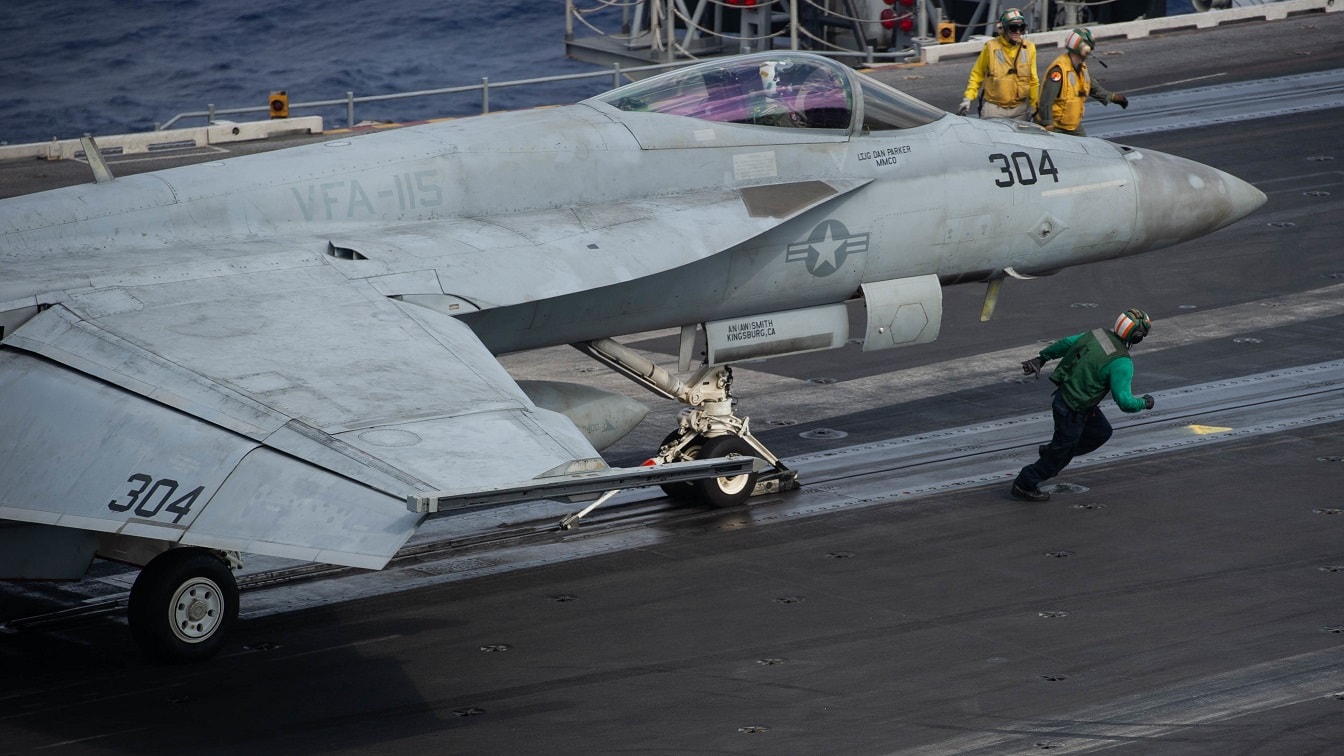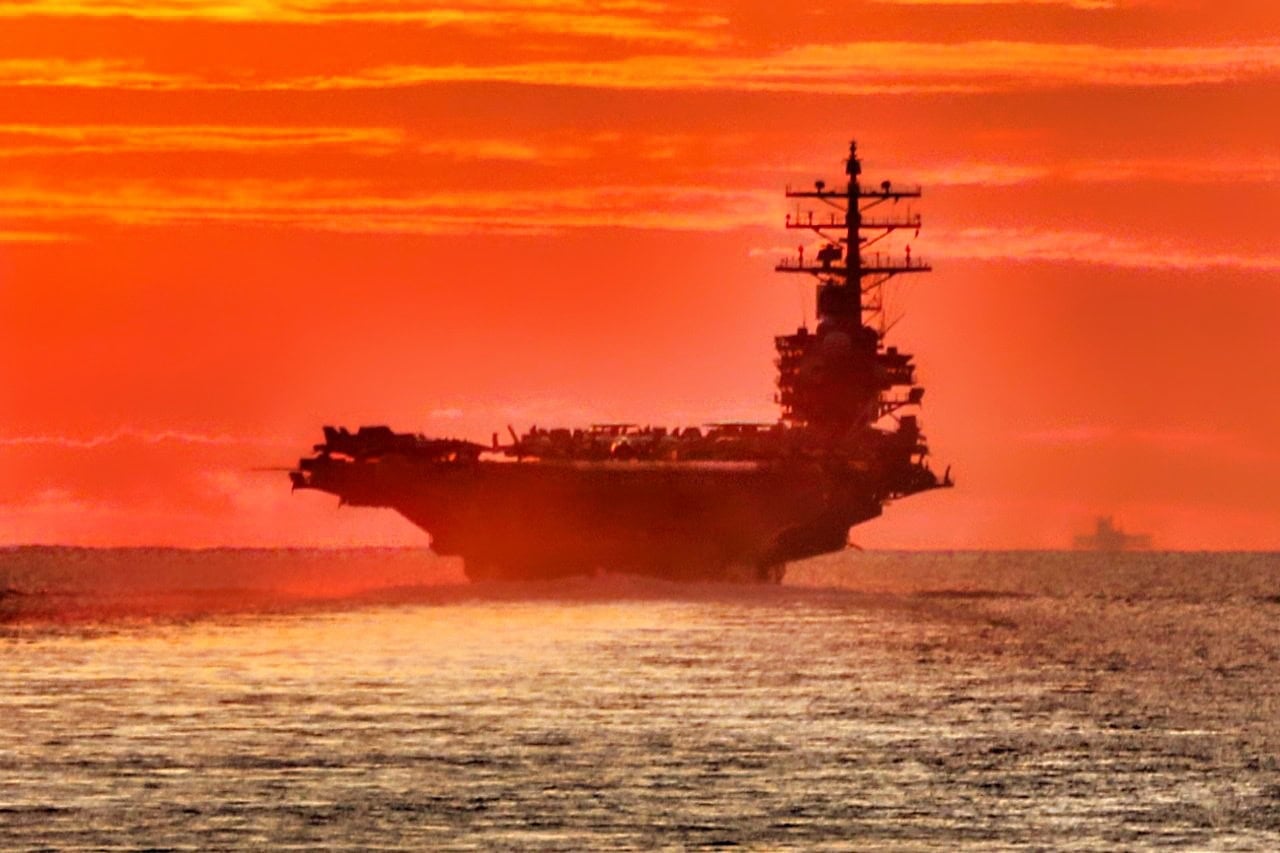Article Summary: China’s growing arsenal of anti-ship missiles, including the DF-26 and DF-21, poses a significant threat to U.S. aircraft carriers operating in the Pacific. To counter this, the U.S. Navy is deploying a layered defense system that includes Rolling Airframe Missiles, SM-series interceptors, and Phalanx close-in weapon systems.
Key Point #1 – Additionally, stealth refueling drones like the MQ-25 Stingray will extend the range of F-35C and Super Hornet fighters, keeping carriers out of missile range.
Key Point #2 – With advanced electronic warfare, lasers, and Aegis-equipped escort ships, the U.S. is working to ensure its carrier strike groups remain dominant in any future conflict with China.
It’s Time to Make U.S. Aircraft Carriers More Survivable
U.S. Navy aircraft carriers are vulnerable in East Asia, and the Americans know it.
China has carrier-killing missiles that create an anti-access/ area denial problem for freedom of navigation in the East and South China Seas.
The U.S. Navy must come up with ways to mitigate Chinese tactics, operations, and strategy in the region, and battle planners and defense contractors are trying to devise means to protect American carriers better.
Rolling Airframe Missiles Are Ones to Watch
They may have devised a system to shield the floating air bases to the maximum level.
Carriers have received the RIM-116 Rolling Airframe Missiles (RAM), which are proving to be an important asset in hardening defenses on flat-tops.
The RAM is an air defense interceptor that “rolls as it flies.” Raytheon touts it as the world’s most modern and advanced missile defender.
Layer the Defense for Hardened Protection
Last spring the USS Abraham Lincoln successfully tested a RAM in the Pacific Ocean. This missile is part of what the Navy calls “layered ship defenses.”
Escort ships in a carrier strike group employ the Aegis Weapon System to form a protective umbrella against enemy aircraft and missiles.
Then, EA-18G Growler electronic warfare airplanes jam incoming munitions and aircraft that could threaten a carrier.
Watch Out for the Carrier-Killers
This is good because China has the DF-26 and DF-21 carrier-killing missiles that can travel up to 2,000 or more miles offshore.
The Navy has known Chinese anti-ship missiles like the Sizzler and Sunburn for at least 20 years. They know that the anti-access tactics that Beijing executes are dangerous to future warfare in East Asia.
Carrier strike groups want freedom of navigation to project power and deter the Chinese from attacking or blockading Taiwan. It is time for better shipborne defenses against the Chinese anti-ship missiles.
Many military analysts believe the carrier-killing missiles will work as advertised, but several questions remain. How many are actually that effective? Can they hit a moving target? Are they being appropriately maintained? Do the Chinese test them enough? Can they be maneuvered in flight? How fast do they travel?
The People’s Liberation Army must answer all of these queries, and U.S. battle planners and intelligence analysts must also be ready for the missiles if they are as good as promised.
China must also overwhelm U.S. defenses with a massive flight of carrier-killers. How many would it take to sneak through and hit one of the flat-tops?
One way the Americans can protect carrier strike groups is to lengthen the range of its F-35C stealth fighters and the F/A-18 E/F Super Hornets. The Americans have devised a stealth aerial re-fueling drone called the MQ-25 Stingray that allows these fighters to take a longer path and destroy the carrier-killers before they can fire.
This means the carrier strike group can stay out of the Chinese missiles’ range and typically conduct carrier operations.
Meanwhile, carrier escort ships are improving when it comes to missile defense. “Navy Arleigh Burke-class DDG 51 destroyers are armed with SM-2, SM-3, and SM-6 interceptor missiles capable of blanketing and protecting short, medium and long-range ballistic missiles with precision tracking and intercept technology designed to ‘knock’ incoming enemy anti-ship missiles out of the sky,” according to Warrior Maven.
Lasers will also be part of the mix as a way to protect ships from incoming missiles. These directed energy systems are still being tested, but it is a technique that is becoming more mature and combat-ready.

Nimitz-class aircraft carrier USS Carl Vinson (CVN 70) transits the Bay of Bengal as part of Maritime Partnership Exercise (MPX), Oct. 16, 2021. MPX 2021 is a multilateral maritime exercise between the Royal Australian Navy, Japan Maritime Self-Defense Force, U.K. Royal Navy, and U.S. maritime forces, focused on naval cooperation, interoperability and regional security and stability in the Indo-Pacific and is an example of the enduring partnership between Australian, Japanese, U.K. and U.S. maritime forces, who routinely operate together in the Indo-Pacific, fostering a cooperative approach toward regional security and stability. (U.S. Navy photo by Mass Communication Specialist 2nd Class Russell Lindsey)
Carriers are also armed with Evolved Sea Sparrow interceptor missiles and close-in weapons systems like the Phalanx which is the final missile shield on board. These armaments have been improved over the years.
This all makes for the layered system that the Navy is confident about. The Chinese are proud of their carrier-killing missiles, but the Americans are actively improving their missile protection. Carrier battle groups can stay out of range as their airplanes are re-fueled to extend the combat radius. The Rolling Airframe Missile is top-notch. Lasers are coming online, and other missile interceptors are showing promise.
This doesn’t mean the Navy can relax. The threat from China’s anti-access/area denial gambit is real. The Americans need to be able to patrol with their carrier battle groups near Taiwan to protect the island in case of a Chinese amphibious attack or blockade.

181115-N-RF825-0074
PHILIPPINE SEA (Nov. 15, 2018) Sailors prepare an F/A-18 Super Hornet, attached to Strike Fighter Squadron (VFA) 115, for take-off from the flight deck of the forward-deployed aircraft carrier USS Ronald Reagan (CVN 76) during dual carrier operations with USS John C. Stennis (CVN 74). Ronald Reagan and John C. Stennis are underway and conducting operations, in international waters as part of a dual carrier strike force operations. The U.S. Navy has patrolled the Indo-Pacific region routinely for more than 70 years promoting regional security, stability, and prosperity. (U.S. Navy photo by Mass Communication Specialist Seaman Jason N. Tarleton/Released)
The layered defense system that forms a protective umbrella over American ships is pivotal to future warfare. Let’s see if the Navy can deliver and protect the fleet if the worst ever happens with China.
About the Author: Dr. Brent M. Eastwood
Brent M. Eastwood, PhD, is the author of Don’t Turn Your Back On the World: a Conservative Foreign Policy and Humans, Machines, and Data: Future Trends in Warfare, plus two other books. Brent was the founder and CEO of a tech firm that predicted world events using artificial intelligence. He served as a legislative fellow for U.S. Senator Tim Scott and advised the senator on defense and foreign policy issues. He has taught at American University, George Washington University, and George Mason University. Brent is a former U.S. Army Infantry officer. He can be followed on X @BMEastwood.

